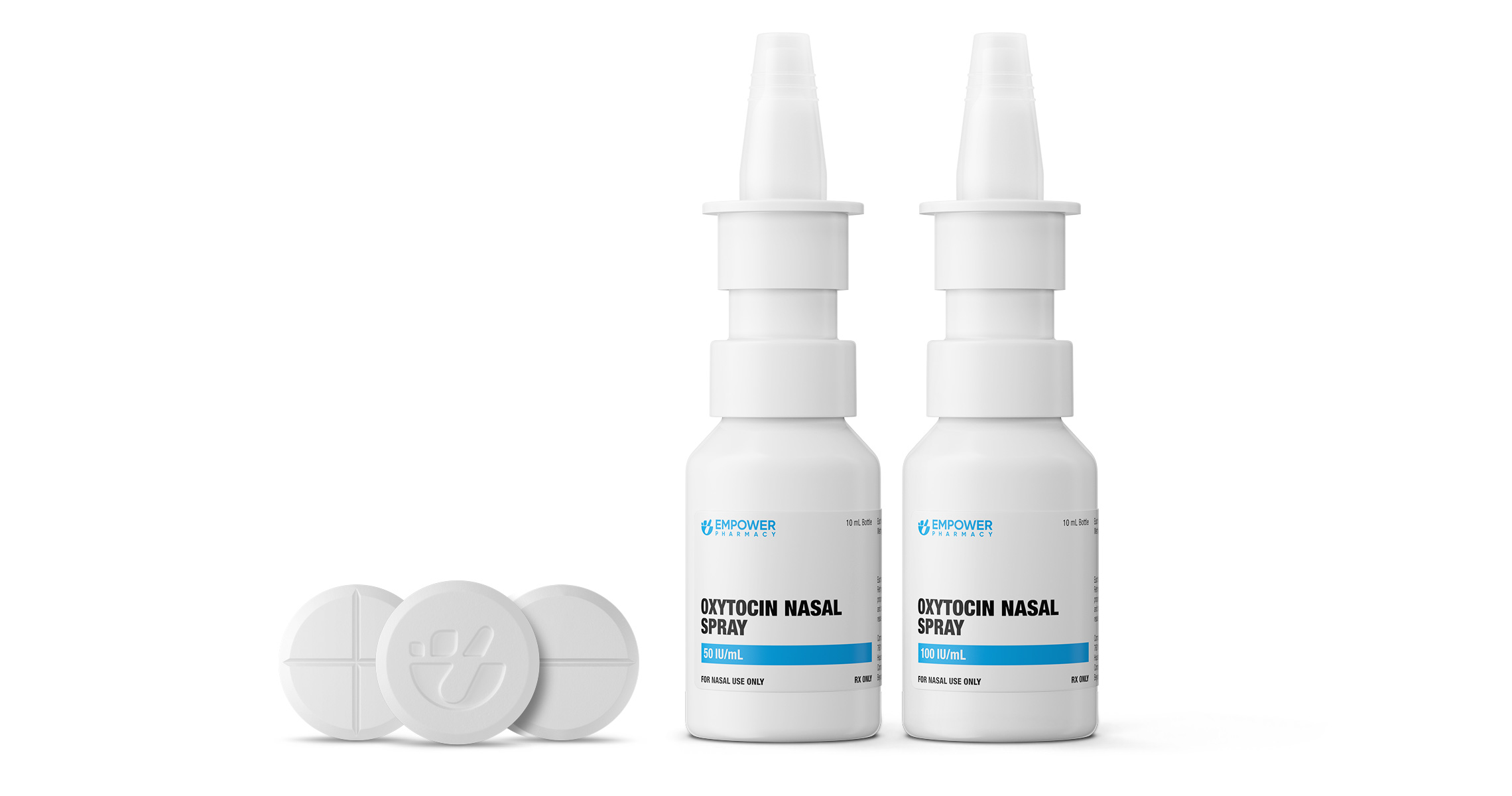Article Summary
Oxytocin, secreted by the pituitary, impacts desire, bonding, and labor. Administered through injection or nasal spray, it aids in labor induction, controls bleeding, and stimulates milk ejection. Known for bonding and social interaction, it influences uterine contraction, milk letdown, and behavior.Oxytocin is a nonapeptide (nine amino acids) hormone secreted by the posterior pituitary. Oxytocin produces action both peripherally and in the brain. Oxytocin is released by males and females during orgasm and is considered by many to be the hormone of desire, social recognition, and bonding. Oxytocin is primarily administered by injection or nasal spray because Chymotrypsin, present in the gastrointestinal tract, destroys oxytocin, rendering oral administration ineffective.[1] Clinically, oxytocin is used most often to induce and strengthen labor and control postpartum bleeding. Intranasal preparations of oxytocin, used to stimulate postpartum milk ejection, are no longer manufactured in the US, so a compounding pharmacy is necessary for this preparation.
Oxytocin has an action on uterine contraction, milk letdown, orgasm, sexual arousal, bonding, and maternal behavior.[2] For this reason, it is sometimes referred to as the “bonding hormone”. There is some evidence that oxytocin promotes ethnocentric behavior, incorporating the trust and empathy of in-groups with their suspicion and rejection of outsiders.[3] Furthermore, genetic differences in the oxytocin receptor gene (OXTR) have been associated with maladaptive social traits such as aggressive behavior.[4]
Oxytocin is a hormone produced mainly by the hypothalamus (an almond-sized region of the brain) and is released either directly into the blood via the pituitary gland, or to other parts of the brain and spinal cord. Best known for its role in childbirth, oxytocin plays a vital role in triggering uterine contractions. Many times if contractions are not powerful enough to complete delivery the mother will be given oxytocin to help the labor process and contractions.[5]
Although Oxytocin is implicated in a variety of “non-social” behaviors, such as learning, anxiety, feeding, and pain perception, it is Oxytocin’s roles in various social behaviors that have come to the fore recently. Oxytocin is important for social memory and attachment, sexual and maternal behavior, and aggression. Recent work implicates Oxytocin in human bonding and trust as well. Human disorders characterized by aberrant social interactions, such as autism and schizophrenia, may also involve Oxytocin expression.[6]
Oxytocin and Lactation
It has been postulated that a rise in the concentration of oxytocin causes contraction of cells around the alveoli and milk ducts, in preparation for suckling, and that lactation failure may result from insufficient oxytocin.[7] When the infant is suckled, afferent impulses from sensory stimulation of nerve terminals in the areolas travel to the central nervous system where they promote the release of oxytocin from the posterior pituitary. In the woman oxytocin release is often associated with such stimuli as the sight or sound or even the thought of the infant indicating a large cerebral component in this “neuroendocrine reflex”. The oxytocin is carried through the blood stream to the mammary gland where it interacts with specific receptors on myoepithelial cells, initiating their contraction and expelling milk from the alveoli into the ducts and sub-areolar sinuses. The passage of milk through the ducts allows free flow of milk to the nipple. The process by which milk is forcibly moved out of the alveoli is called milk ejection or let-down and is essential to milk removal from the lactating breast.[8] Oxytocin nasal spray has been used successfully to help treat for “the let-down effect”.[9] There is speculation that in addition to facilitating lactation and the birthing process, the hormone facilitates the emotional bond between mother and child.[10]
Oxytocin and Autism
Oxytocin has recently received significant interest in the Autism community. Researchers have found that autistic children have lower plasma levels of oxytocin than those of other children. Oxytocin plays a role in social behavior, including but not limited to: repetitive behaviors, the desire to form social bonds, social recognition, processing social cues, regulated feeding, excessive grooming, stress response and being aloof.
One study, published in The Proceedings of the National Academy of Sciences, found that the hormone, given as an inhalant, generated increased activity in parts of the brain involved in social connection. Oxytocin facilitated social attunement, a process that makes the brain regions involved in social behavior and social cognition activate more for social stimuli (such as faces) and activate less for non-social stimuli (such as cars). This suggests not only that oxytocin can stimulate social brain areas, but also that in children with autism these brain regions are not irrevocably damaged but are plastic enough to be influenced.[11][12][13][14][15][16][17]
Oxytocin and Sexual Response
Recent studies show that Oxytocin is involved in multiple signaling pathways in the central and peripheral nerve system and mainly regulates the physiology and activity of reproduction, including male reproduction and sexual behavior. The roles of Oxytocin in penile erection are bio-phasic with proerectile effect in the central nerve system while peripherally inhibiting erection. Oxytocin also mediates ejaculation, post-ejaculatory detumescence and the post-orgasm refractory period.[18][19]
Oxytocin has also become the subject of studies in female sexual dysfunction specifically difficulty achieving orgasm. Oxytocin increases sexual receptivity and counteracts impotence.[20] Oxytocin can be used to help treat Female Orgasmic Disorder, Female Arousal Disorder or for those women who just desire a more powerful or multiple orgasms.[21]
Recent research has shown that oxytocin may have many other far-reaching effects particularly when it comes to relationships and emotional involvement. Oxytocin is the reason why we form all sorts of deep connections not only with our children, but with our partners, friends and even our pets and is often called the “bonding hormone”. Oxytocin also plays a huge role in the non-procreative aspects of sex.
Research has shown that for women, not only is oxytocin released during orgasm, it appears to be responsible for causing orgasms in the first place. Research indicates that oxytocin causes the nerves in the genitals to fire spontaneously, and this leads to powerful orgasms. In women, during orgasm, oxytocin levels increase significantly. During peak sexual arousal, if a woman’s brain is flooded with oxytocin, she may indeed be capable of multiple orgasms.[22]
Sometimes called “the cuddle hormone”, oxytocin is released in response to a variety of environmental stimuli including skin-to-skin contact and cervical stimulation experienced during sex. At normal levels oxytocin encourages a mild desire to be kissed and cuddled by partners. Being touched (anywhere on the body) leads to a rise in oxytocin levels. This causes a cascade of reactions within the body, including the release of endorphins which results in both biological and psychological arousal.[23]
- Package Insert for Pitocin and Syntocinon from www.drugs.com accessed December 2007.
- Lee HJ, Macbeth AH, Pagani JH, Young WS (June 2009). “Oxytocin: the great facilitator of life”. Prog. Neurobiol. 88 (2): 127–51.
- De Dreu CK, Greer LL, Van Kleef GA, Shalvi S, Handgraaf MJ (January 2011). “Oxytocin promotes human ethnocentrism”. Proc. Natl. Acad. Sci. U.S.A. 108 (4): 1262–6
- Malik AI, Zai CC, Abu Z, Nowrouzi B, Beitchman JH (July 2012). “The role of oxytocin and oxytocin receptor gene variants in childhood-onset aggression”. Genes Brain Behav. 11 (5): 545–51.
- Guinn, D. A.; Davies, J. K.; Jones, R. O.; Sullivan, L.; Wolf, D. (2004). “Labor induction in women with an unfavorable Bishop score: Randomized controlled trial of intrauterine Foley catheter with concurrent oxytocin infusion versus Foley catheter with extra-amniotic saline infusion with concurrent oxytocin infusion”. American Journal of Obstetrics and Gynecology 191 (1): 225–229.
- Prog Neurobiol. 2009 Jun;88(2):127-51. Epub 2009 Apr 10. Oxytocin: the great facilitator of life. Lee HJ, Macbeth AH, Pagani JH, Young WS 3rd. Section on Neural Gene Expression, NIMH, NIH, DHHS, Bethesda, MD 20892, USA.
- Renfrew MJ1, Lang S, Woolridge M. “Oxytocin for promoting successful lactation.” Cochrane Database Syst Rev. 2000;(2):CD000156
- Neville, Margaret C. “Lactogenesis: The Transition from Pregnancy to Lactation Oxytocin and Milk Ejection.” 1998. University of Colorado Denver. Department of Physiology
- Applied Therapeutic: The Clinical Use of Drugs. Sixth Edition; 1997: 44-29.
- Cabanac M, Pfaff DW, Ogawa S, et al. Neural oxytocinergic systems as genomic targets for hormones and as modulators of hormone-dependent behaviors. Results Probl Cell Differ 1999;26:91-105.
- Insel TR, O’Brien DJ, Leckman JF (1999): Oxytocin, vasopressin, and autism: is there a connection? Biol Psychiatry 45:145-147.
- Hollander E, Novotny S, Hanratty M, Yaffe R, DeCaria CM, Aronowitz BR, Mosovich S (2003): Oxytocin infusion reduces repetitive behaviors in adults with autistic and Aspberger’s disorders. Neuropsychopharmacology 28:193-198.
- Modahl C, Green L, Fein D, Waterhouse L, Feinstein C, Morris M, Levin H (1998): Plasma oxytocin levels in autistic children. Biol Psychiatry 43:270-277.
- Waterhouse L, Fein D, Modahl C (1996): Neurofunctional mechanisms in autism. Psychol Rev 103:457-489.
- McCarthy MM, Altemus M (1997): Central nervous system actions of oxytocin and modulation of behavior in humans. Mol Med Today 3:269-275.
- Panksepp J (1992): Oxytocin effects on emotional processes: separation distress, social bonding, and relationships to psychiatric disorders. Ann NY Acad Sci 652:243-252.
- Popik P, Vetulani J, van Ree JM (1992): Low doses of oxytocin facilitate social recognition in rats. Psychopharmacology (Berl) 106:71-74
- Zhonghua Nan Ke Xue. 2011 Jun;17(6):558-61. Oxytocin and male sexual function.
- Argiolas, A and Melis, M. Cagliari. Oxytocin-Induced Penile Erection, Role of Nitric Oxide, Italy: 247; 1995. Plenum Press, New York.
- Pedersen, C.A., Boccia, M.A. “Oxytocin Maintains as Well as Initiates Female Sexual Behavior: Effects of a Highly Selective Oxytocin Antagonist”), 2002. Hormones and Behavior. Volume 41, Issue 2, March 2002, Pages 170–177.
- Oxytocin Cellular and Molecular Approaches in Medicine and Research. Increased female sexual response after Oxytocin. Anderson-Hunt M and Dennerstein L. Brit Med J 309:929: 236; 1994 Plenum Press, New York.
- Carmichael MS, Humbert R, Dixen J, et al. Plasma Oxytocin increases in the human sexual response. J Clin Endcrinol Metab, 1987. 64:27-31.
- Pedersen, C.A., 2002. Oxytocin increases sexual receptivity and counteracts impotence, (Arletti, 1997)




